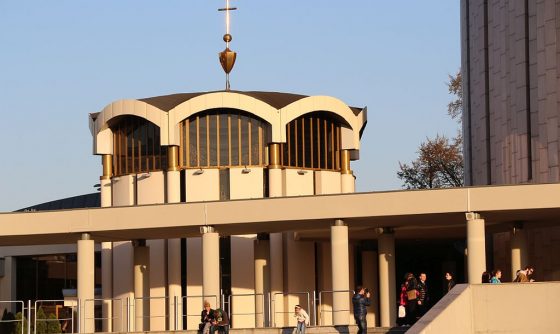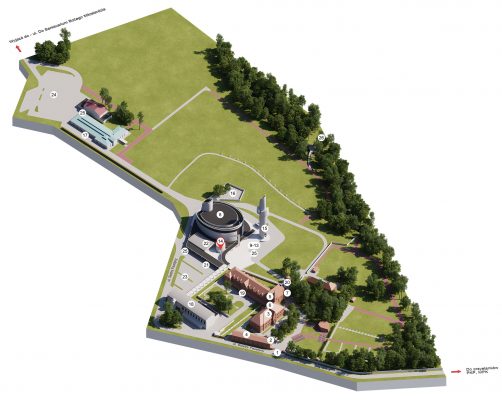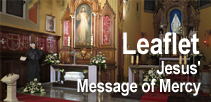We have put a map of the Shrine after the text.
The Chapel of Perpetual Adoration is next to the Basilica. It was designed by Witold Cęckiewicz and has the shape of a rotunda with large glass panels containing stained glass with a floral decoration. The altar in the shape of a bonfire containing the monstrance is in the centre of the Chapel. The sanctuary lamp hangs over the altar and contains the flame of Mercy lit by Pope John Paul II in 2003 as a symbol of the message of Divine mercy disseminated from here all over the world. Cardinal Franciszek Macharski consecrated the Chapel on the Feast of Mercy in 2004 and started a 24-hour Adoration of the Blessed Sacrament. A year later, the Pope’s wish to have Perpetual Adoration in the Shrine of Łagiewniki was fulfilled. In a letter he wrote for the Feast of Mercy, just two days before his death, giving it a testamentary quality, he wrote, “I am glad that Perpetual Adoration of the Blessed Sacrament will start this Sunday. Nothing can match the Lord’s Eucharistic presence as a manifestation of the work of mercy He conducted on the Cross and in His Resurrection. So let His presence be a source of strength and hope for all the pilgrims.” Ever since, the Chapel of Perpetual Adoration at Łagiewniki has been open day and night, and pilgrims have been praying here before the Blessed Sacrament for God’s mercy on themselves, the Holy Church, our Country, and the whole world.
“When I immersed in prayer I was transported in spirit to the chapel,” Sister Faustina wrote, “. . . but instead of the monstrance I saw the glorious face of the Lord, Who said to me, ‘What you are seeing in reality these souls see through faith’” (Diary 1420). She spent every moment of her free time at the feet of Jesus in the Blessed Sacrament. He was her Master. “I ask Him about everything; I tell Him everything; this is where I draw strength and light from; here I learn all things; this is where my lights come from on how to behave with respect to my neighbours” (Diary 704).
Sister Faustina’s spiritual experience gives us a better understanding of the mystery of Divine mercy in the Eucharist, in the Sacraments, in the Word of God and in the Holy Church, her beloved mother the Mystical Body of Christ. That is why she said that every good deed a believer does, even a small thing like a smile or a gesture, and also every time he sins or is unfaithful to the Church ‒ all these things find their reflection in the Church. “O, how I love the Holy Church and all who live in her; I look on them as living members of Christ, Who is their head. I am aflame with love with those who are loving; I suffer with those who are suffering; I am anguished and pained when I look at those who are cold and ungrateful; at such times I try to make my love of God make amends to Him for those who do not love Him” (Diary 481).
Since 2021, a round-the-clock internet service has been available online from the Chapel of Perpetual Adoration on our website www.misericordia.eu
- Main entrance to the Shrine
- Sister Faustina’s House: hotel & museum
- Convent
- Antoninek House: Faustinum Association
-
Merciful Jesus Chapel & Saint Faustina’s Tomb: Heart of the Shrine
- Oratory: room where Saint Faustina died
- Chapel of the Lord’s Passion
- Divine Mercy Basilica
- Saint Faustina’s Chapel
- The Communio Sanctorum Chapel
- Saint Andrew’s Chapel
- The Holy Cross Chapel
- The Chapel of Our Lady of the Seven Sorrows
- Perpetual Adoration Chapel
- Viewing Tower
- Convent Graveyard
- Sister Faustina’s House: restaurant, souvenirs & meeting hall
- Pastoral Lodge: hotel & restaurant
- Mercy House
- Information Booth
- Souvenirs & Misericordia Bookshop
- Saint John Paul II Hall
- Car park
- Car and coach park
- Toilets
- Bridge of Mercy, for the Saint John Paul II Shrine & tram stop

















